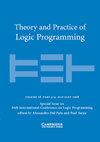Locksynth:用ASP派生并发数据结构的同步代码
IF 1.1
2区 数学
Q3 COMPUTER SCIENCE, SOFTWARE ENGINEERING
引用次数: 0
摘要
我们提出Locksynth,一个工具,自动派生所需的同步破坏性更新并发数据结构,涉及恒定数量的共享堆内存写操作。Locksynth是我们之前在派生抽象同步代码方面的工作的实现。设计并发数据结构需要从事先了解顺序数据结构的操作开始,推断出正确的同步代码。此外,还需要了解共享内存模型和同步原语。将顺序数据结构转换为其并发版本的推理可以使用答案集编程来执行,并且我们在前面的工作中机械化了我们的方法。推理包括演绎和溯因,可以在ASP中简洁地建模。我们假设提供了数据结构操作的抽象顺序代码,以及描述并发行为的公理。此信息用于自动派生该数据结构的并发代码,例如链表和二叉搜索树的字典操作,这些操作涉及恒定数量的破坏性更新操作。我们还能够推断出涉及左/右树旋转的外部高度平衡二叉搜索树的正确锁集(但不是代码合成)。Locksynth执行推断正确锁集所需的分析,并作为最后一步,为合成的数据结构派生c++同步代码。我们还提供了由Locksynth合成的c++代码的性能分析,并使用了Synchrobench微基准套件中提供的手工版本。据我们所知,我们的工具是第一个使用ASP作为后端推理器来执行并发数据结构合成的工具。本文章由计算机程序翻译,如有差异,请以英文原文为准。
Locksynth: Deriving Synchronization Code for Concurrent Data Structures with ASP
Abstract We present Locksynth , a tool that automatically derives synchronization needed for destructive updates to concurrent data structures that involve a constant number of shared heap memory write operations. Locksynth serves as the implementation of our prior work on deriving abstract synchronization code. Designing concurrent data structures involves inferring correct synchronization code starting with a prior understanding of the sequential data structure’s operations. Further, an understanding of shared memory model and the synchronization primitives is also required. The reasoning involved transforming a sequential data structure into its concurrent version can be performed using Answer Set Programming, and we mechanized our approach in previous work. The reasoning involves deduction and abduction that can be succinctly modeled in ASP. We assume that the abstract sequential code of the data structure’s operations is provided, alongside axioms that describe concurrent behavior. This information is used to automatically derive concurrent code for that data structure, such as dictionary operations for linked lists and binary search trees that involve a constant number of destructive update operations. We also are able to infer the correct set of locks (but not code synthesis) for external height-balanced binary search trees that involve left/right tree rotations. Locksynth performs the analyses required to infer correct sets of locks and as a final step, also derives the C++ synchronization code for the synthesized data structures. We also provide a performance analysis of the C++ code synthesized by Locksynth with the hand-crafted versions available from the Synchrobench microbenchmark suite. To the best of our knowledge, our tool is the first to employ ASP as a backend reasoner to perform concurrent data structure synthesis.
求助全文
通过发布文献求助,成功后即可免费获取论文全文。
去求助
来源期刊

Theory and Practice of Logic Programming
工程技术-计算机:理论方法
CiteScore
4.50
自引率
21.40%
发文量
40
审稿时长
>12 weeks
期刊介绍:
Theory and Practice of Logic Programming emphasises both the theory and practice of logic programming. Logic programming applies to all areas of artificial intelligence and computer science and is fundamental to them. Among the topics covered are AI applications that use logic programming, logic programming methodologies, specification, analysis and verification of systems, inductive logic programming, multi-relational data mining, natural language processing, knowledge representation, non-monotonic reasoning, semantic web reasoning, databases, implementations and architectures and constraint logic programming.
 求助内容:
求助内容: 应助结果提醒方式:
应助结果提醒方式:


